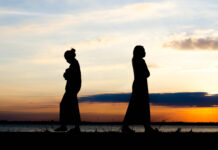I am driving down a maze of twisty roads into the dusk, guided by the beams of my headlights. It is that in-between time that is both night and day, light and dark. In this rural neighborhood, streetlights are scattered about at random intervals, as far apart as lighthouses on the sea, and I know that as soon as the sky turns completely dark, the only reprieve from the thick, inky blackness will come when I am thrust into the blinding glare of passing cars.
Nothing can frighten me quite like the night.
As a child, the night was a living thing, a breeding ground for all things sinister. The streets teemed with kidnappers, robbers, wild six-legged creatures.
When we moved to Brooklyn after our wedding, I’d often walk back to our apartment after a friend’s l’chayim or wedding at late hours. The farther I got from the lights, the people, the pulsing heart of the neighborhood, the stronger my fear became. My eyes would search the empty streets and if I saw a vague outline of a person, my hands would flutter into my purse, grabbing my phone and pepper spray, a most practical gift that may or may not have been intended as a gag gift. I’d whisper Shir Hamaalos and race through the streets, bursting into our apartment with phone and pepper spray still clenched in my fists. I’d tell my husband of the vague outline of a person, loitering very suspiciously at the entrance of a decrepit home.
“I think,” I’d tell him, “I need to bentch gomel.”
“I think,” he’d tell me, “you need to get used to Brooklyn.”
I thought that when we moved to a suburb of New York that’s quaint enough to still be called a village, with trees more abundant than homes and backyards larger than Brooklyn parks, my fear of the night would melt into yesterday’s dreams.
But here I am, snaking through our lovely streets, desperate to get home while streaks of color are still visible in the sky. Night falls quickly. The bushes beyond the glass turn into creepy, hulking masses. Branches hanging low overhead are quivering tentacles. The friendly homes, with well-manicured lawns, look haunted.
And that is when I see the sign. I cannot make out the words, but I’ve read it in the daylight enough times to know what it says. “Preserve Our Neighborhood.”
A few blocks away there’s another that says, “No Soliciting.” When I first saw signs like those, I didn’t understand. It was the same way I didn’t understand the cool, artificial greetings from our new bare-headed neighbors and the defeated look on the faces of the people from whom we purchased our home.
Shortly after our move, we heard that some nearby towns tried to close the doors of their public parks to non-residents.
“They want to keep us out,” my husband explained.
“But why?”
“Because they’re upset that we’re religious Jews who have big families. We build multi-family housing. They believe that we come to neighborhoods in swarms and take them over.”
I considered this.
There was a modicum of truth in it.
There always is.
Stereotypes are built upon shreds of truth.





















